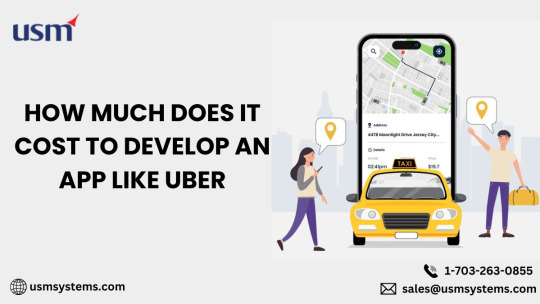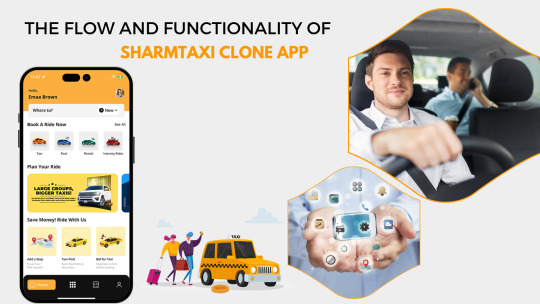#taxiappdevelopment
Explore tagged Tumblr posts
Text
#taxibookingapp#uberclone#ubercloneapp#applikeuber#uberclonescript#ridehailingapp#taxiserviceapp#taxiappdevelopment#appdevelopment#apps
1 note
·
View note
Text
Discover how to launch a successful taxi-booking app in untapped Asian markets. Learn the pros and cons of building from scratch vs. buying ready-made solutions.
0 notes
Text
Gojek Clone App Development: Build Your Own Multiservice App

As everything goes online, consumers seek convenience, speed, and efficiency, all wrapped into one seamless experience. Enter the Gojek clone app a robust, all-in-one multiservice platform designed to cater to a wide range of daily needs, from ride-hailing and food delivery to home services, grocery shopping, courier dispatch, and more. For entrepreneurs and businesses aiming to tap into the lucrative on-demand economy, developing a taxi booking app like Gojek presents an exciting opportunity to establish a powerful digital presence.
What is a Gojek Clone App?
A Gojek clone app is a ready-made, customizable multiservice app solution inspired by the Indonesian tech giant Gojek. It integrates a suite of services into a single application, allowing users to access multiple services through one login and one unified platform.
Typically, a Gojek clone includes core modules such as:
On-demand taxi booking
Food and grocery delivery
Parcel delivery
Home services (plumbing, electrical, cleaning, etc.)
Beauty and wellness
Two-wheeler or car rentals
E-wallet integration
Live tracking and real-time notifications
Why Invest in a Gojek Clone App?
1. Growing On-Demand Economy: The global on-demand app market continues to witness exponential growth. Multiservice apps provide immense convenience and are increasingly preferred by users who want to save time and effort.
2. Higher User Retention: Users are more likely to stay engaged with your platform when they can access multiple services from one app, instead of switching between different apps for each need.
3. Diverse Revenue Streams: With multiple services under one roof, you can generate income from various channels, commissions from vendors, delivery fees, in-app advertising, subscription models, and premium service charges.
4. Competitive Edge: Offering a single app for multiple services positions your brand as a comprehensive solution provider, enhancing market credibility and competitive advantage.
Key Features of a Successful Gojek Clone App
To stand out and deliver maximum value, your Gojek clone app must include user-centric features and smooth functionality:
User Panel
Easy registration/login
Service booking and scheduling
Real-time tracking
Multiple payment options
Reviews and ratings
Service Provider Panel
Profile management
Order management
Earnings dashboard
Availability toggles
Admin Panel
Service/category management
Commission and pricing control
User/vendor analytics
Promotions and push notifications
Multi-language & currency support
Tech Stack for Gojek Clone App Development
Choosing the right technology stack ensures scalability, performance, and security. Common technologies include:
Frontend: React Native / Flutter for cross-platform compatibility
Backend: Node.js / Laravel / Django
Database: MongoDB / MySQL / PostgreSQL
Payment Gateway: Stripe, PayPal, Razorpay
APIs: Google Maps, Twilio, Firebase
How to Launch Your Gojek Clone App?
1. Market Research & Service Mapping: Analyze the target market to decide which services to include based on demand and competition.
2. Choose a Reliable Development Partner: Work with a professional app development company experienced in multiservice platforms.
3. Customize & Brand the App: Tailor the design, features, and workflows to align with your business model and brand identity.
4. Test Rigorously: Conduct beta testing to identify bugs, UI/UX issues, and performance bottlenecks.
5. Deploy & Promote: Launch your app across app stores and promote it via digital marketing, influencer campaigns, and referral incentives.
Final Thoughts
The Gojek clone app is more than just a tech trend, it’s a strategic business model that aligns with the modern consumer’s demand for convenience and immediacy. Whether you're a startup aiming to disrupt your local market or an established business looking to diversify your offerings, investing in Gojek clone app development could be your gateway to long-term growth and profitability.
0 notes
Text

Launch your online taxi business with TraviPro’s custom cab booking portal development. Get real-time tracking, secure payments, driver panels & more. Visit: https://www.travipro.com/cab-booking-portal-development.html
#CabBookingPortalDevelopment#TaxiAppDevelopment#OnlineCabBooking#TravelTechnology#FleetManagementSoftware#TaxiBusinessOnline#MobilitySolutions#TraviPro#OnDemandAppDevelopment#RideHailingPlatform
0 notes
Text
Indriver Clone App by Appicial – The Smartest Way to Launch a Taxi Business
Indriver Clone App by Appicial – The Smartest Way to Launch a Taxi Business
Introduction
The global ride-hailing market is booming, and the demand for flexible, user-friendly platforms is at an all-time high. One of the standout models is InDriver, which revolutionized the ride-hailing industry by allowing passengers and drivers to negotiate prices directly. If you're an entrepreneur looking to tap into this lucrative industry, building an Indriver clone app is a smart way to enter the market without reinventing the wheel.
In this blog, we will explore how Appicial's Indriver Clone App offers a fast, scalable, and cost-effective solution to help you launch your very own ride-hailing business with the same features and functionalities as InDriver. Let’s dive into why this clone app is the smartest choice for your taxi business.
What Is an Indriver Clone App?
An Indriver Clone App is a white-label solution that replicates the key features of the InDriver platform. The main distinguishing feature of the InDriver app is its unique fare negotiation system. Unlike other ride-hailing apps, passengers can propose a fare, and drivers can either accept, reject, or counter the offer. This system promotes transparency and flexibility, making it a favorite among both drivers and riders.
Appicial's Indriver Clone App offers a ready-to-launch platform with customizable features, allowing you to start your taxi business efficiently and at a low cost.
Why Choose the Indriver Clone App by Appicial?
Customizable Features Appicial’s Indriver Clone App comes with flexible and customizable features to suit your specific business needs. Whether you’re targeting price-sensitive customers or offering premium services, the app can be tailored to match your vision.
Fare Negotiation System The key feature of the Indriver Clone is the fare negotiation system. Passengers can set a price, and drivers can either accept or suggest a new fare. This system promotes transparency and mutual respect between drivers and passengers.
User-Friendly Interface Appicial’s Indriver Clone App boasts an intuitive interface for both passengers and drivers, making it easy for users of all ages to navigate the app. Simple, effective, and engaging designs ensure a smooth experience for everyone involved.
Real-Time GPS Tracking The app integrates real-time GPS tracking, allowing passengers to track their driver’s location and estimated arrival time. This feature increases trust and transparency in the service, enhancing the overall user experience.
Multiple Payment Options The app supports a range of payment options including credit/debit cards, digital wallets, and cash, allowing users to choose the payment method that’s most convenient for them.
Scalable and Secure Built on a robust and scalable platform, Appicial’s Indriver Clone App can handle increasing traffic and data, making it the perfect solution for businesses looking to expand. The app is also designed with top-notch security measures to protect user data and transactions.
Key Features of Appicial’s Indriver Clone App
🧍 For Riders:
Fare Bidding – Riders suggest their fare, and drivers can negotiate.
Real-Time Trip Tracking – Riders can track their ride in real-time.
Multiple Payment Methods – Choose from cash, wallet, or card.
Ratings and Reviews – Riders can rate drivers based on the quality of the ride.
Ride History – Keep track of all your previous rides.
🚗 For Drivers:
Accept/Reject/Counter Offers – Drivers can negotiate fares with passengers.
Online/Offline Mode – Drivers can toggle their availability.
Trip History & Earnings – Drivers can access past trip details and earnings.
Navigation – In-app GPS navigation for optimal routes.
Instant Notifications – Get notified of new ride requests instantly.
🛠️ Admin Panel:
User Management – Admins can manage both riders and drivers.
Trip Monitoring – Track the status of all active rides in real-time.
Fare Control – Set base fares and monitor negotiations.
Reports & Analytics – View detailed reports and analytics of app usage.
Commission Settings – Set the commission percentage from drivers.
Technology Stack Used for Indriver Clone App
ComponentTechnologyFrontend (App)Flutter / React Native / KotlinBackendNode.js / PHP (Laravel) / PythonDatabaseMongoDB / MySQL / PostgreSQLGPS/MapsGoogle Maps API / MapboxReal-time ChatFirebase / Socket.ioPayment GatewayStripe, Razorpay, PayPal, etc.
How to Launch Your Taxi Business with Indriver Clone App?
Market Research Before launching, research the market, your target audience, and the competition. Understanding your local demand will help you shape your business and app strategy effectively.
Choose a Development Partner Choose a reliable app development company like Appicial that specializes in ride-hailing apps and has experience in delivering high-quality, scalable solutions.
Customizations & Branding Customize your app's look and feel to match your branding. Appicial provides a white-label solution, allowing you to make changes in the app design, logo, and colors to reflect your brand identity.
App Development & Testing Appicial’s team will help you build the app, integrate essential features, and ensure it works flawlessly. Rigorous testing ensures the app runs smoothly on both Android and iOS devices.
Launch & Marketing After your app is ready, it’s time to launch. Promote your app through social media, online ads, and local marketing campaigns to attract drivers and riders.
Continuous Monitoring & Improvement Once the app is live, keep monitoring its performance and user feedback. Appicial offers post-launch support and maintenance, ensuring the app stays up-to-date and bug-free.
Cost of Building an Indriver Clone App
The cost of building an Indriver clone app can vary based on several factors such as features, customizations, and the development company you choose. On average, the cost may range between:
Basic App (MVP): $5,000 to $8,000
Full-Featured App: $10,000 to $20,000+
The investment in building a feature-rich and customizable app can bring great returns in the competitive ride-hailing industry.
Conclusion
Launching a taxi business with an Indriver Clone App by Appicial is the smartest way to enter the booming ride-hailing market. With its unique fare negotiation feature, user-friendly interface, and customizable solutions, Appicial's Indriver Clone App gives you the tools you need to create a scalable, efficient, and profitable business.
By partnering with Appicial, you can save time, money, and effort in developing a top-notch ride-hailing platform. Ready to launch your taxi business? Get in touch with Appicial today to start your journey toward success in the ride-hailing industry!
#TaxiBusiness#AppDevelopment#RideHailingApp#CloneApp#SmartTaxiApp#TaxiStartup#Appicial#RideHailingBusiness#TaxiAppDevelopment
1 note
·
View note
Text
Launch Your Taxi Booking Solution
The taxi service industry is shifting gears and making serious strides in the business world!
Innovators aren’t stopping at just cars or bikes—they’re launching out-of-the-box taxi solutions that are changing the game.
Want to launch your own innovative taxi solution?
Book your free consultation with our development experts now!
Visit Us: https://www.inventcolabssoftware.com/taxi-app-development

#taxiappdevelopment#taxiservice#taxi dispatch software#taxiapp#appdevelopment#mobileappdevelopment#techinnovation#techtrends#digitalinnovation
0 notes
Text

Technology has a significant importance in our society and is increasingly essential in our everyday lives. main reasons why technology is so important
1 note
·
View note
Text

Backend development is crucial for managing ride requests, payments, and user authentication. You can use cloud-based solutions like AWS or Google Cloud for secure data handling. For seamless user experience, integrate third-party APIs like Google Maps for navigation and Twilio for SMS notifications. Additionally, implementing an AI-driven algorithm for optimal ride matching can improve efficiency. Testing your app thoroughly before launch ensures smooth functionality. Once deployed, continuous updates and marketing strategies will help you compete in the market. For a step-by-step guide on creating an app like Uber in 2024, visit this link: https://www.intelegain.com/creating-an-app-like-uber-in-2024-step-by-step-process-and-key-factors/
#TaxiAppDevelopment#BuildUberLikeApp#RideSharingApp#UberClone#AppDevelopment#TaxiBookingApp#OnDemandApp#MobilitySolutions#RideHailingApp#AppDevelopment2024#StartupIdeas#TechInnovation#MobileAppDevelopment#AIinTransport#TaxiBusiness#UberAlternative#SmartTransport#AppDevelopmentGuide#Entrepreneurship#AppTech
0 notes
Text
#TaxiDispatchSoftware#CabManagement#FleetManagement#TaxiAppDevelopment#TransportationTech#RideHailingSolutions#SmartDispatch#CabBookingSystem#TaxiServiceSoftware#DigitalTransportation
0 notes
Text
Launch your own taxi app fast, pick a top development partner for success and standout features!
1 note
·
View note
Text

On-Demand Taxi Booking App Development Company
Experience our taxi app development to get 100% customization, user-friendly driver, passenger & taxi dispatch app facilitating easy ride booking.
#TaxiBookingApp#TaxiBookingAppinIndia#TaxiBookingAppDevelopment#TaxiBookingAppDevelopmentinIndia#TaxiBookingAppDevelopmentCompany#TaxiBookingAppDevelopmentService#TaxiBookingAppIdeas#OnDemandTaxiBookingApp#TaxiAppDevelopment#TaxiAppDevelopmentinIndia
0 notes
Text
Top Challenges Developers Face in Taxi App Development

The global demand for taxi booking apps has increased in recent years. With services like Uber, Lyft, and Ola redefining urban mobility, many startups and transport businesses are eager to launch their own taxi apps. However, developing a taxi booking app is not as simple as it may seem.
In this article, we’ll explore the top challenges developers and businesses face while taxi app development and how to address them effectively.
1. Real-Time GPS Tracking and Navigation
Challenge: Accurate location tracking is critical for both drivers and passengers. GPS glitches, incorrect routing, or slow updates can lead to poor user experience.
Solution: Use reliable mapping APIs like Google Maps, Mapbox, or HERE, and implement fallback mechanisms in case of location loss. Optimize background location tracking for minimal battery drain.
2. Handling Real-Time Requests and Matching Algorithms
Challenge: Managing hundreds or thousands of users requesting rides simultaneously requires an efficient matching algorithm that pairs drivers and riders in real-time.
Solution: Leverage robust backend technologies like Node.js, Redis, and socket-based communication. Implement load balancing and use location clustering to improve request distribution.
3. Secure and Seamless Payments
Challenge: Integrating secure payment methods, supporting various currencies, and offering multiple payment options (card, wallet, UPI, etc.) can be complex and regulated.
Solution: Use PCI-DSS-compliant gateways like Stripe, Razorpay, or Braintree. Enable tokenization for user data security and offer localized payment solutions for different markets.
4. Multi-Platform Compatibility (iOS & Android)
Challenge: Ensuring consistent performance and user experience across both Android and iOS devices, while keeping taxi booking app development cost-efficient, is a major challenge.
Solution: Consider cross-platform frameworks like Flutter or React Native to reduce development time while maintaining quality. For larger enterprises, native development might be preferred.
5. Scalability and Performance
Challenge: Taxi apps must be ready to scale as user demand grows—especially during peak times or geographic expansion.
Solution: Use a microservices architecture, cloud hosting (AWS, GCP, Azure), and scalable databases like MongoDB or PostgreSQL. Regularly stress-test your infrastructure.
6. Data Privacy and Compliance
Challenge: Handling user data, real-time locations, and payment information requires strict adherence to privacy regulations like GDPR, HIPAA, or local laws.
Solution: Implement end-to-end encryption, anonymize location data where needed, and maintain transparency with users about data usage. Always comply with region-specific legal standards.
7. Managing Driver and Rider Behavior
Challenge: Ensuring reliable service means managing unpredictable human behavior, cancellations, fraud, late arrivals, or disputes.
Solution: Build features like ratings, feedback, SOS buttons, cancellation policies, and in-app support. Use AI or pattern recognition to detect suspicious activity.
8. Localization and Market Adaptation
Challenge: If you're targeting multiple regions or countries, your app must adapt to different languages, currencies, traffic laws, and cultural expectations.
Solution: Design your app with multi-language support, real-time currency conversions, and local holiday/surge pricing logic. Understand the local ecosystem before launching.
9. Integrating Advanced Features
Challenge: Modern users expect more than just booking. Features like ride scheduling, fare splitting, loyalty programs, or AI-based ETA predictions can be hard to implement well.
Solution: Start with an MVP (Minimum Viable Product), then gradually introduce features. Use AI and machine learning for predictive analytics and route optimization.
Final Thoughts
Building a successful taxi app requires more than just sleek design and smooth booking flows. It demands technical expertise, infrastructure planning, regulatory compliance, and a deep understanding of user behavior. By being aware of these challenges upfront, you can develop more robust, user-friendly, and scalable on-demand taxi booking apps.
0 notes
Text

How much does it cost to develop an app like Uber
Developing an app like Uber involves various factors, including user interface design, GPS integration, payment gateways, and backend development. The cost depends on the complexity of features like real-time tracking, driver-partner interface, and customer support. Creating a robust ride-sharing app requires expertise in handling large user bases and seamless functionality. For premium app development services, USM Business Systems is the best mobile app development company, offering tailored solutions to meet your business needs.
#UberAppCost#AppDevelopmentCost#UberCloneApp#RideSharingApp#TaxiAppDevelopment#AppLikeUber#MobileAppCost#RideSharingTech#UberCloneDevelopment#TaxiBookingApp
0 notes
Text
Rideshare App Development: Trends, Models, and Top Apps to Watch in 2024

Interested in developing a taxi-booking app? 🚖 Dive into the world of ridesharing apps that are transforming public transport, reducing road congestion, and fighting climate change. Learn about the popular app models, including peer-to-peer and aggregator models, and discover which rideshare app fits your needs. Get the latest stats on Lyft, Uber, Ola, and more to make informed decisions for your development project. 📲 read more : https://on-demand-app.com/top-rideshare-apps-driving-on-demand-shared-mobility
0 notes
Text
How to Develop a Taxi App Like Bolt: Features, Cost & Process
Learn how to develop a taxi app like Bolt with expert insights into taxi app development. Discover key features, cost estimation, and a step-by-step process for a successful ride-hailing app.

#taxiappdevelopment#taxibusiness#taxi dispatch software#taxiapp#taxiservice#appdevelopment#mobileappdevelopment#appdevelopmentcompany#techinnovation#softwaredevelopment#techtrends
0 notes
Text
Flow And Functionality Of Sharmtaxi Clone App
Sharmtaxi Clone is a Cash Cow for Millions of Entrepreneurs within the United States of America itself.

#cubetaxi#sharmtaxiclone#appfunctionality#userexperience#taxiappdevelopment#seamlessflow#ridehailing
1 note
·
View note